Understanding Vehicle Window Tint
Vehicle window tint is a popular aftermarket modification that provides numerous benefits, such as enhancing privacy, reducing glare, and blocking harmful UV rays. Tint is typically measured by the percentage of visible light transmission (VLT) it allows through the windows. The lower the VLT percentage, the darker the tint appears. When choosing between 20% and 35% tint, you need to consider your preferences and local laws regarding window tint darkness.
What Does 20% Tint Mean?
A 20% tint means that the film allows only 20% of visible light to pass through the windows. This percentage indicates that the tint is relatively dark and provides significant privacy and heat rejection. While 20% tint is ideal for those seeking a dramatic look and increased privacy, it may not be legal in all states. Be sure to check your local regulations before installing 20% tint on your vehicle.
What Does 35% Tint Mean?
On the other hand, 35% tint allows 35% of visible light to pass through the windows, making it slightly lighter than 20% tint. This level of tint provides a good balance between style, privacy, and visibility, making it a popular choice among vehicle owners. 35% tint offers a sleek appearance while still allowing for decent visibility both during the day and at night. Additionally, 35% tint is often within the legal limits in many states.
Factors to Consider When Choosing Between 20% and 35% Tint
Choosing between 20% and 35% tint depends on several factors, including personal preference, desired level of privacy, local laws, and practicality. Consider the following factors before deciding on the tint level for your vehicle:
Personal Style and Preference
Your personal style and preference play a significant role in choosing the right tint level for your vehicle. If you prefer a darker, more dramatic look, 20% tint may be the better option for you. On the other hand, if you want a balance between style and visibility, 35% tint might be more suitable. Consider how you want your vehicle to look and what level of privacy you desire when making your decision.
Legal Regulations
Before selecting a tint level for your vehicle, it’s crucial to check the legal regulations in your state or country. Each jurisdiction has specific laws regarding the darkness of window tint, and exceeding these limits can result in fines or citations. Make sure to research and understand the tint laws in your area to ensure compliance with local regulations.
Visibility and Safety
Another essential factor to consider is visibility and safety on the road. Darker tints, such as 20%, can reduce visibility, especially at night or in low-light conditions. If visibility is a concern for you, opting for a lighter tint, like 35%, may be a safer choice. Maintaining good visibility is crucial for safe driving, so consider how different tint levels can impact your ability to see clearly both during the day and at night.
Heat Rejection and UV Protection
Window tint not only enhances the aesthetics of your vehicle but also provides practical benefits, such as heat rejection and UV protection. Darker tints, like 20%, are more effective at blocking heat and UV rays compared to lighter tints. If you live in a hot climate or want maximum protection from the sun’s harmful rays, 20% tint may be the better option for you. However, keep in mind that darker tints can also impact the interior temperature of your vehicle.
Pros and Cons of 20% Tint
Pros:
- Enhanced privacy
- Superior heat rejection
- Increased UV protection
- Sleek and stylish appearance
Cons:
- Reduced visibility, especially at night
- Potential legal issues in some jurisdictions
- Higher interior temperature in extreme heat
Pros and Cons of 35% Tint
Pros:
- Balanced visibility and privacy
- Adequate heat rejection
- UV protection
- Compliance with many tint laws
Cons:
- Less privacy compared to 20% tint
- Slightly reduced heat rejection
- Limited customization options
Conclusion
In conclusion, the difference between 20% and 35% tint lies in the amount of visible light transmission each allows through the windows. While 20% tint offers superior privacy and heat rejection, it may not be legal in all areas and can affect visibility. On the other hand, 35% tint provides a good balance between style, visibility, and compliance with tint laws. When deciding between these two tint levels, consider your personal preferences, local regulations, safety concerns, and practicality to make an informed choice. Whichever tint level you choose, Xclusive Wraps and Tint is here to provide high-quality tinting services to elevate and protect your vehicle.



